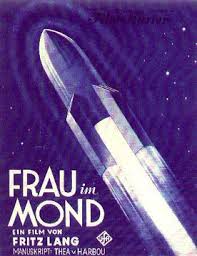
Professor Georg Manfeldt (Klaus Pohl) is a scientist. He believes that there is gold on the moon. His peers think he is a crack pot. His theory is laughed at, and so is he. Many years later his friend Wolf Helius (Willy Fritsch) visits him at his run down home. Helius is an entrepreneur who has a fascination of space and is building a rocket ship. Helius has decided to go to the moon.
A group of businessmen and woman that have cornered the market in the gold business are concerned. They think that gold should be in the hands of businessmen and not visionaries. They send an agent, Walter Turner (Fritz Rasp) to steal Helius’ plans and threaten to destroy all his work if the agent is not allowed to represent the businessmen in a partnership with Helius and his project.
Helius’s friend and aide Engineer Hans Windegger (Gustav von Wangenheim) is engaged to Friede Velton (Gerda Maurus). She is Helius’ assistant and Helius is secretly in love with her. Until now Helius has kept Windegger out of his plans in deference to Friede’s love for Windegger. Now he has no choice but to inform Windegger about the plot against the space ship. Windegger wants to go with Helius to the moon, and so does Friede. To save his ship Helius reluctantly agrees to Turner’s demands. Turner also insists on going along.
The team manning the space ship with Helius are Professor Manfeldt, along with his pet mouse Josephine, Windegger, Friede and of course Turner. After the ship is launched they find a stow away aboard in the form of a young boy, Gustav (Gustl Gstettenbaur). Gustav is a friend of Helius and is fascinated with science fiction stories.
Now with a crew of six instead of five, the space ship, also named Friede, is on route to the moon. Soon their numbers will dwindle and unforeseen problems will jeopardize everyone. Only a selfless act can save what’s left of the crew.
“Woman in the Moon” or “Die Frau im Mond” was released in 1929 and was directed by Fritz Lang. Epic in scale, it is the last silent film Lang directed. It is based on the book “Woman in the Moon” by Thea von Harbou who was Lang’s wife at the time. It is a long movie. Fritz liked to do long movies to cover a double bill.
There were several variations of the film. Anywhere from a mere 91 minutes long to 200 minutes long. The biggest restoration done was for the full 200 minute film, or three hours and twenty minutes, in 2000 but it is difficult to find. Kino did an English title card version that is 169 minutes long, or two hours and forty-nine minutes, in 2004. The movie didn’t do as well as it should have at the box office since most movies were starting to move toward sound in the late twenties.
There are some interesting firsts for the film. The first countdown to a launch. Not only for the movie but in real life as well. The countdown for the film was done for dramatic effect. It was then incorporated in the launching of real missiles and rockets. It was also the first use of liquid rocket fuel, the first two stage rocket and the depiction of zero gravity in space.
When the Nazis began creating rockets for war they determined that the schematics and models in the film were a little too close to home so they had the models destroyed and the film was pulled from release. All in the name of secrecy. Lang hired German physicist Hermann Oberth as a technical advisor for the film so the rocket for the movie was probably true to life. Oberth was considered one of the founding fathers of rocketry and aeronautics. He worked on the German V-2 rocket program; the world’s first long range guided ballistic missile. He was a mentor to Wernher von Braun and after WWII moved to the US where he worked for the US government for years. He was a technical consultant for NASA’s Atlas rocket.
Yes the movie got a lot of things wrong, but they got a lot of things right too. It’s also really, really long, but really, really good.

